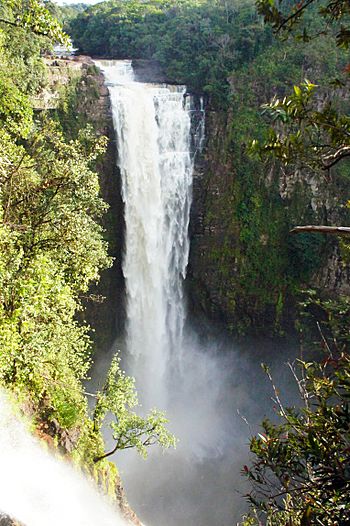Kamarang River facts for kids
Quick facts for kids Kamarang River |
|
|---|---|
 |
|
| Country | Venezuela, Guyana (Disputed) |
| Physical characteristics | |
| Main source | 1,350 m (4,430 ft) |
| River mouth | 480 m (1,570 ft) |
| Basin features | |
| Waterfalls | Kamarang Great Falls |
The Kamarang River is an important river that flows through parts of Venezuela and Guyana. It is a branch of the larger Essequibo River system.
Contents
Where the Kamarang River Flows
The Kamarang River starts in Venezuela, where it is known as Río Camarán or Río Camurán. Its source is found near a main road called Troncal 10, in the middle of a large, beautiful area known as the Gran Sabana.
At first, the river flows alongside the road, heading southeast. After a few meters, it crosses the road near a place called Campamento Kamoiran. Here, the river forms exciting rapids known as the Kamoiran rapids. The river then turns more towards the east, flowing through open grasslands for several kilometers.
Journey into Guyana
Soon after, the Kamarang River enters a territory that is claimed by both Venezuela and Guyana, known as Guayana Esequiba. Once in Guyana, the river drops about 160 meters (525 feet) at the amazing Kamarang Great Falls. These falls create a wide curtain of water, about 40 meters (130 feet) across!
After the falls, the Kamarang River flows through a deep, forested valley. It first heads north, then turns east. This area is very remote and not many people visit it. It is home to the Arecuna people. The river continues flowing east through the forest until it joins the Mazaruni River at a mining village called Kamarang.
Kamarang Great Falls
The Kamarang Great Falls, also known as Kamarang Meru, is a stunning waterfall. It plunges off the edge of the Pacaraima Mountains in a very isolated part of western Guyana. It is only a few kilometers from the Venezuelan border.
The waterfall is 145 meters (476 feet) high. Because of the huge amount of water that flows over it, Kamarang Great Falls is one of the most powerful waterfalls in Guyana.
Discovery of the Falls
It is believed that an American scientist named Paul A. Zahl first discovered these falls in 1938. He was an entomologist, which means he studied insects, and also a doctor. Paul A. Zahl wrote that the sound of the falling water was so loud that it could be heard long before the falls themselves could be seen!
See also
 In Spanish: Río Camarán para niños
In Spanish: Río Camarán para niños

